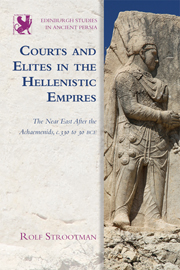Book contents
- Frontmatter
- Contents
- List of Illustrations
- Acknowledgements
- Abbreviations
- The Hellenistic Dynasties
- Series Editor's Preface
- Map
- Introduction: Court and Empire in the Hellenistic Near East
- PART I SETTING THE SCENE
- PART II THE COURT AS A SOCIO-POLITICAL SYSTEM
- PART III CEREMONIAL AND RITUAL
- 9 Ceremonial and Protocol
- 10 Death and Resurrection: Inauguration Ritual
- 11 The Royal Entry
- 12 Royal Processions: Enacting the Myth of Empire
- Conclusion
- Bibliography
- Index
10 - Death and Resurrection: Inauguration Ritual
from PART III - CEREMONIAL AND RITUAL
Published online by Cambridge University Press: 05 September 2014
- Frontmatter
- Contents
- List of Illustrations
- Acknowledgements
- Abbreviations
- The Hellenistic Dynasties
- Series Editor's Preface
- Map
- Introduction: Court and Empire in the Hellenistic Near East
- PART I SETTING THE SCENE
- PART II THE COURT AS A SOCIO-POLITICAL SYSTEM
- PART III CEREMONIAL AND RITUAL
- 9 Ceremonial and Protocol
- 10 Death and Resurrection: Inauguration Ritual
- 11 The Royal Entry
- 12 Royal Processions: Enacting the Myth of Empire
- Conclusion
- Bibliography
- Index
Summary
Ancient sources suggest that the installation of a new king and the burial of his predecessor were interrelated ritual events: the transmission of basileia, preferably from father to son. The successor was transformed into the new master of the household. This obliged him to pay the last honours to his predecessor and, if necessary and possible, to revenge his death. Thus, in 336, Alexander, ‘succeeding to the kingship, first inflicted due punishment on his father's murderers, and then devoted himself to the funeral of his father’.
Before succession could take place, a period of mourning had to be observed. This allowed time for the burial and inauguration to be prepared and announced. It took time for people to travel to the court to attend the inauguration of the new ruler. Also, the army had to be assembled and its allegiance secured. The presence of the army at the coronation was imperative. The period of mourning was a period of ritually enacted anomy. When Antiochos, the favourite son and intended successor of Antiochos the Great, died, relations between the Seleukid court and the outside world were formally brought to a standstill, as if time itself had temporarily stopped: ‘There was a great sorrow at the court [and] grave mourning filled the palace for several days; and the Roman ambassador, who did not want to be an untimely guest at such an inconvenient moment, retired to Pergamon … [for] the court was closed during the mourning.’
- Type
- Chapter
- Information
- Courts and Elites in the Hellenistic EmpiresThe Near East After the Achaemenids, c. 330 to 30 BCE, pp. 210 - 232Publisher: Edinburgh University PressPrint publication year: 2014



